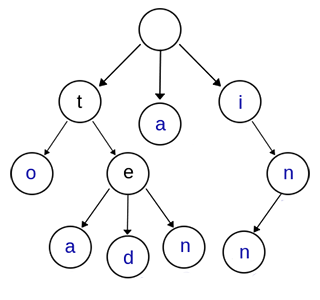在 GitHub 的页面上有很多快捷键可以使用,比如键入 g + c 键选中 Code 标签页,键入 g + i 选中 Issues 标签页。这里是 GitHub 支持的快捷键列表open in new window。那么,这么丰富的快捷键,是如何来实现的呢?我们今天就通过 GitHub 官方的 @github/hotkeyopen in new window 来一窥究竟。
功能描述
在需要支持快捷键的元素上,通过 data-hotkey 属性添加快捷键序列,然后通过 @github/hotkey 暴露的 install 方法使得快捷键生效。
<a href="/page/2" data-hotkey="j">Next</a>
<a href="/help" data-hotkey="Control+h">Help</a>
<a href="/rails/rails" data-hotkey="g c">Code</a>
<a href="/search" data-hotkey="s,/">Search</a>
2
3
4
import {install} from '@github/hotkey'
// Install all the hotkeys on the page
for (const el of document.querySelectorAll('[data-hotkey]')) {
install(el)
}
2
3
4
5
6
添加快捷键的规则是:
- 如果一个元素上支持多个快捷键,则不同的快捷键之间通过
,分割。 - 组合键通过
+连接,比如Control + j。 - 如果一个快捷键序列中有多个按键,则通过空格
连接,比如g c。
我们在这里可以查到键盘上每个功能按键对应事件键值名称open in new window,方便设置快捷键。
如何实现
我们先看 install 函数的实现。
export function install(element: HTMLElement, hotkey?: string): void {
// 响应键盘输入事件
if (Object.keys(hotkeyRadixTrie.children).length === 0) {
document.addEventListener('keydown', keyDownHandler)
}
// 注册快捷键
const hotkeys = expandHotkeyToEdges(hotkey || element.getAttribute('data-hotkey') || '')
const leaves = hotkeys.map(h => (hotkeyRadixTrie.insert(h) as Leaf<HTMLElement>).add(element))
elementsLeaves.set(element, leaves)
}
2
3
4
5
6
7
8
9
10
11
在 install 函数中有两部分功能,第一部分是注册快捷键,第二部分是响应键盘输入事件并触发快捷键动作。
注册快捷键
因为代码较短,我们逐行说明。
首先,通过 expandHotkeyToEdges 函数解析元素的 data-hotkey 属性,获得设置的快捷键列表。快捷键的设置规则在前面功能描述中已经说明。
export function expandHotkeyToEdges(hotkey: string): string[][] {
return hotkey.split(',').map(edge => edge.split(' '))
}
2
3
之后通过这行代码实现了快捷键注册。
const leaves = hotkeys.map(h => (hotkeyRadixTrie.insert(h) as Leaf<HTMLElement>).add(element))
最后一行实则是一个缓存,方便在 uninstall 函数中删除已经添加的快捷键,不赘述了。
因此,整个注册过程核心就是 hotkeyRadixTrie,hotkeyRadixTrie 是一棵前缀树,在系统启动时就已经初始化。
const hotkeyRadixTrie = new RadixTrie<HTMLElement>()
所谓前缀树,就是 N 叉树的一种特殊形式。通常来说,一个前缀树是用来存储字符串的。前缀树的每一个节点代表一个字符串(前缀)。每一个节点会有多个子节点,通往不同子节点的路径上有着不同的字符。子节点代表的字符串是由节点本身的原始字符串,以及通往该子节点路径上所有的字符组成的。
在 @github/hotkey 中,有两个类一起实现了前缀树的功能,RadixTrie 和 Leaf。
Leaf 类,顾名思义就是树的叶子节点,其中保存着注册了快捷键的元素。
export class Leaf<T> {
parent: RadixTrie<T>
children: T[] = []
constructor(trie: RadixTrie<T>) {
this.parent = trie
}
delete(value: T): boolean {
const index = this.children.indexOf(value)
if (index === -1) return false
this.children = this.children.slice(0, index).concat(this.children.slice(index + 1))
// 如果叶子节点保存的所有元素都已经删除,则从前缀树中删除这个叶子节点
if (this.children.length === 0) {
this.parent.delete(this)
}
return true
}
add(value: T): Leaf<T> {
// 在叶子节点中添加一个元素
this.children.push(value)
return this
}
}
2
3
4
5
6
7
8
9
10
11
12
13
14
15
16
17
18
19
20
21
22
23
24
25
26
RadixTrie 类实现了前缀树的主体功能,RadixTrie 的功能实现其实是树中的一个非叶子节点,它的子节点可以是一个 Leaf 节点,也可以是另一个 RadixTrie 节点。
export class RadixTrie<T> {
parent: RadixTrie<T> | null = null
children: {[key: string]: RadixTrie<T> | Leaf<T>} = {}
constructor(trie?: RadixTrie<T>) {
this.parent = trie || null
}
get(edge: string): RadixTrie<T> | Leaf<T> {
return this.children[edge]
}
insert(edges: string[]): RadixTrie<T> | Leaf<T> {
let currentNode: RadixTrie<T> | Leaf<T> = this
for (let i = 0; i < edges.length; i += 1) {
const edge = edges[i]
let nextNode: RadixTrie<T> | Leaf<T> | null = currentNode.get(edge)
// If we're at the end of this set of edges:
if (i === edges.length - 1) {
// 如果末端节点是 RadixTrie 节点,则删除这个节点,并用 Leaf 节点替代
if (nextNode instanceof RadixTrie) {
currentNode.delete(nextNode)
nextNode = null
}
if (!nextNode) {
nextNode = new Leaf(currentNode)
currentNode.children[edge] = nextNode
}
return nextNode
// We're not at the end of this set of edges:
} else {
// 当前快捷键序列还没有结束,如果节点是一个 Leaf 节点,则删除这个节点,并用 RadixTrie 节点替代
if (nextNode instanceof Leaf) nextNode = null
if (!nextNode) {
nextNode = new RadixTrie(currentNode)
currentNode.children[edge] = nextNode
}
}
currentNode = nextNode
}
return currentNode
}
}
2
3
4
5
6
7
8
9
10
11
12
13
14
15
16
17
18
19
20
21
22
23
24
25
26
27
28
29
30
31
32
33
34
35
36
37
38
39
40
41
42
43
我们可以看到,RadixTrie 的 insert 方法会根据前面 expandHotkeyToEdges 方法获取到的快捷键列表,在当前 RadixTrie 节点上动态的添加新的 RadixTrie 或者 Leaf 节点。在添加过程中,如果之前已经有相同序列的快捷键添加,则会覆盖之前的快捷键设置。
insert 方法返回一个 Leaf 节点,在前面的获取快捷键列表然后批量调用 insert 方法之后,都会调用返回的 Leaf 节点的 add 方法将这个元素添加到叶子节点中去。
响应键盘输入事件
有了前缀树以后,响应键盘输入事件就是根据输入的键值遍历前缀树了。功能在 keyDownHandler 函数中。
function keyDownHandler(event: KeyboardEvent) {
if (event.defaultPrevented) return
if (!(event.target instanceof Node)) return
if (isFormField(event.target)) {
const target = event.target as HTMLElement
if (!target.id) return
if (!target.ownerDocument.querySelector(`[data-hotkey-scope=${target.id}]`)) return
}
if (resetTriePositionTimer != null) {
window.clearTimeout(resetTriePositionTimer)
}
resetTriePositionTimer = window.setTimeout(resetTriePosition, 1500)
// If the user presses a hotkey that doesn't exist in the Trie,
// they've pressed a wrong key-combo and we should reset the flow
const newTriePosition = (currentTriePosition as RadixTrie<HTMLElement>).get(eventToHotkeyString(event))
if (!newTriePosition) {
resetTriePosition()
return
}
currentTriePosition = newTriePosition
if (newTriePosition instanceof Leaf) {
let shouldFire = true
const elementToFire = newTriePosition.children[newTriePosition.children.length - 1]
const hotkeyScope = elementToFire.getAttribute('data-hotkey-scope')
if (isFormField(event.target)) {
const target = event.target as HTMLElement
if (target.id !== elementToFire.getAttribute('data-hotkey-scope')) {
shouldFire = false
}
} else if (hotkeyScope) {
shouldFire = false
}
if (shouldFire) {
fireDeterminedAction(elementToFire)
event.preventDefault()
}
resetTriePosition()
}
}
2
3
4
5
6
7
8
9
10
11
12
13
14
15
16
17
18
19
20
21
22
23
24
25
26
27
28
29
30
31
32
33
34
35
36
37
38
39
40
41
42
43
这段代码可以分成三个部分来看。
第一部分是一些校验逻辑,比如接收到的事件已经被 preventDefault 了,或者触发事件的元素类型错误。对于表单元素,还有一些特殊的校验逻辑。
第二部分是恢复逻辑。因为用户输入是逐个按键输入的,因此 keydown 事件也是逐次触发的。因此,我们需要一个全局指针来遍历前缀树。这个指针一开始是指向根节点 hotkeyRadixTrie 的。
let currentTriePosition: RadixTrie<HTMLElement> | Leaf<HTMLElement> = hotkeyRadixTrie
当用户停止输入之后,不管有没有命中快捷键,我们需要将这个指针回拨到根节点的位置。这个就是恢复逻辑的功能。
function resetTriePosition() {
resetTriePositionTimer = null
currentTriePosition = hotkeyRadixTrie
}
2
3
4
第三部分就是响应快捷键的核心逻辑。
首先会通过 eventToHotkeyString 函数将事件键值翻译为快捷键,是的键值与前缀树中保存的一致。
export default function hotkey(event: KeyboardEvent): string {
const elideShift = event.code.startsWith('Key') && event.shiftKey && event.key.toUpperCase() === event.key
return `${event.ctrlKey ? 'Control+' : ''}${event.altKey ? 'Alt+' : ''}${event.metaKey ? 'Meta+' : ''}${
event.shiftKey && !elideShift ? 'Shift+' : ''
}${event.key}`
}
2
3
4
5
6
之后,在当前节点指针 currentTriePosition 根据新获取的键值获取下一个树节点。如果下一个节点为空,说明未命中快捷键,执行恢复逻辑并返回。
如果找到了下一个节点,则将当前节点指针 currentTriePosition 往下移一个节点。如果找到的这个新节点是一个 Leaf 节点,则获取这个叶子节点中保存的元素,并在这个元素上执行 fireDeterminedAction 动作。
export function fireDeterminedAction(el: HTMLElement): void {
if (isFormField(el)) {
el.focus()
} else {
el.click()
}
}
2
3
4
5
6
7
fireDeterminedAction 执行的动作就是,如果这个元素是一个表单元素,则让这个元素获取焦点,否则触发点击事件。
 关注微信公众号,获取最新推送~
关注微信公众号,获取最新推送~
 加微信,深入交流~
加微信,深入交流~

